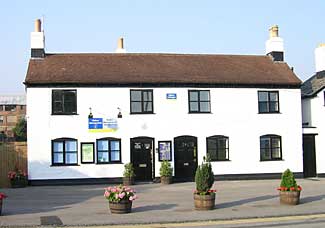 Origin Origin
Named
after the former Albion Hotel, the large stone building on the opposite
side of Southgate Street, the cottages were first recorded in 1821
on land almost certainly owned by Samuel Jones, a prominent local
brushmaker who also owned the adjoining property fronting on to
Southgate St. This was six years before the canal was completed,
and it seems that the original tenants had no connection with dockside
activities.
Dock Traders
As the canal neared completion, however,
commercial activity in the area increased, and in 1826 both cottages
were rented by traders who were evidently expecting to handle goods
brought in by boat. The cottage on the left was occupied by Isaac
Cox, a coal merchant, and the other cottage by Thomas Mansell, a
stone and marble mason who also sold beer from the premises in later
years. It is likely that both men made use of the horse-operated
tramroad that ran past the front of their cottages to carry their
products to customers in Gloucester and possibly on to Cheltenham.
In 1835, Isaac Cox was replaced by Robert Monk, a blacksmith, who
presumably provided shoes for the horses collecting goods from the
docks, including those pulling wagons on the tramroad.
Canal Company Employees
In 1847, the cottages were purchased
by the Gloucester & Berkeley Canal Company when the land on
which they were built was separated from Samuel Jones's other property
by the new docks branch of the Midland Railway which came through
to the left of the cottages. After this, apart from Robert Monk
who continued for a few years, all subsequent tenants were employees
of the Canal Company. At various times during the nineteenth century,
they included two toll clerks at Gloucester Lock, a lockman, three
members of the Canal Company's engineering staff and two drivers
of the steam pumping engine on the opposite side of the Main Basin.
Twentieth Century
In the twentieth century, a notable
character who lived in the right hand cottage was Jesse Hooper,
known as the Captain. He had been a sailing ship master and did
a variety of jobs around the docks, including skippering the steam
launch Sabrina when the directors inspected the canal. Even in retirement,
he always wore a peaked cap, and he walked around the docks as though
he owned the place. The last residents moved out around 1980, and
then the cottages were used for offices and storage. The left hand
cottage became the office for the docks police, and later the other
became the office for the staff setting up the National Waterways
Museum. Then in 1993, both cottages were taken over by the Gloucester
Docks Trading Co. for their administrative and security staff, later
joined by staff of the South West Region Development Agency managing
the redevelopment of the area. |